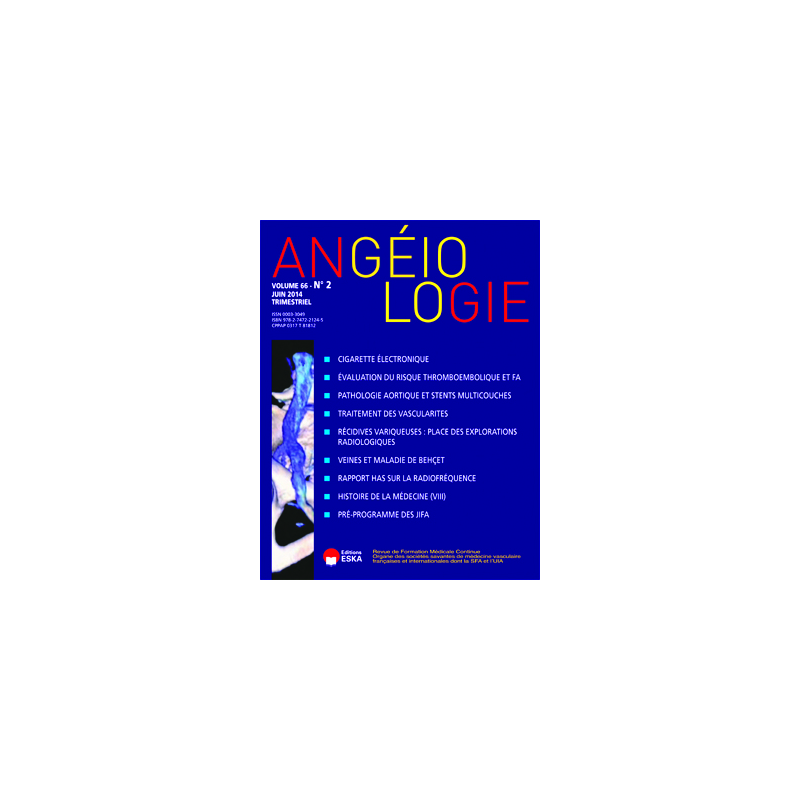



 Security policy
Security policy
(edit with the Customer Reassurance module)
 Delivery policy
Delivery policy
(edit with the Customer Reassurance module)
Article: Our experience of multilayer stent in treatment of complex aortic pathologies
M. N. Bouayed (1), L.A. Bouziane (2)
(1) Professeur Mohamed Nadjib Bouayed -
Chef de service de chirurgie vasculaire à l’Etablissement Hospitalo-Universitaire d’Oran Algérie
Tél/Fax : +213 41 53 89 45, E-mail : bouayed_mohamed@yahoo.fr
(2) Bouziane Leila Ahlam
Maître assistante en chirurgie vasculaire à l’Etablissement Hospitalo-Universitaire d’Oran Algérie.
Abstract
Purpose: The aim of our study was to evaluate the role of multilayer stents in the therapeutic arsenal of complex aortic pathologies in fragile patients combining several risk factors that are initially objected to the conventional surgical treatment
Materials and methods: From March 2012, we conducted a prospective study, mono-centric to a series of 41 procedures performed on 41 lesion locations on 38 patients treated by multilayer stents (MLS). The series is divided into four groups. The first group includes 21 cases: 20 thoracoabdominal aneurysms classified Crawford type I: 2 cases, type II: 4 cases Type III: 4 cases, type IV : 10 cases and one aneurysm of the entire descending thoracic aorta. The average diameter of these aneurysms was 71mm (54 - 98mm).
The second group consists of case 7 in juxta and under renal aneurysms and the average diameter of 73mm is [62 - 97mm]. The third group comprises 5 cases of false aneurysms. The fourth group includes 8 cases of aortic dissection hematoma or extended dissections 3 patients were treated in the same operation for a double aneurysm location (thoracic and abdominal in 2 cases and aortic arch and thoracic aorta in the 3rd case).
The series includes 25 men and 13 women with an average age of 63 ans (40 - 84 years). The procedures were performed under local anesthesia in 3 cases (7.89 %), loco regional in 19 cases (50%) and in general 16 cases (42.11%). The average hospital stay was 7 days (4 -14 days).
Results: The initial technical success was 100%. There was no paraplegia, no stroke and no mesenteric ischemia. Three complications related to the surgical approach were treated surgically with success. Two patients had post operative renal failure, one of them was dialyzed (2.63%).
The 30-day mortality associated with aneurysm was 2.63% (1 case of rupture in the first postoperative day) and unrelated to the aneurysm 2.63% (a case of massive myocardial infarction after the procedure). A mean follow up of 12 months (1 to 20 months) mortality unrelated to the aneurysm was 23.68% ( 9 deaths ) and in relation to the aneurysm 0%. Of the 38 locations lesion treated and followed, the aneurismal sac was not supplied in 14 cases (63.15% ) with 6/20 cases (30% ) in group 1, 3/6 cases (50%) in group 2, 3/4 cases (75 %) in group 3 and finally 2/6 cases ( 33.33 %) in the first sub group of group 4. The aneurismal sac is poorly supplied in 19 cases (50 %), including 14/20 cases (70 %) in group 1, 2/ 6 cases (33.33%) in group 2 , 1/4 cases (25 %) in the group 3 and 2/ 6 cases (33.33%) in the first sub group of group 4. 2 cases of extensive dissections treated remained stable without aneurismal changes. 3 cases (7.89 %) are still recent study which 1/6cas (16/ 66%) in group 2 and 2/6 (33.33%) of the first sub group of group 4. Visceral arteries remained patent in 100 % of cases.
Conclusion: MLS may be an option treatment for dissections and complex aortic aneurysms in frail patients at high surgical risk. The results are interesting in false aneurysms and true aneurysms without significant collateral.